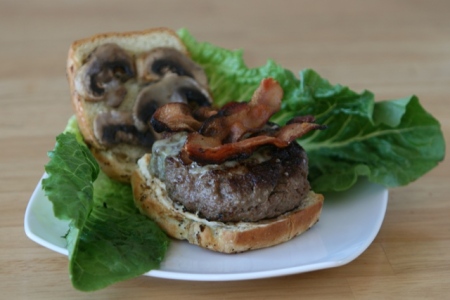I love burgers. I mean who doesn’t? And a burger with bacon on it? My god. Shoot me (please don’t). Everybody loves bacon. Even vegetarians.
It’s a shame that the way most Americans get their burgers in this country is either through the drive-thru window of a fast food chain or from a big frozen box of a dozen or more identical, boring, tasteless, and probably E. Coli-infested “burger patties.” It’s even worse because it doesn’t take much time or effort to make a great burger yourself, at home. To boot, it’s satisfying work, and the results are tastier and healthier than the crap you can buy on every other city block.
This burger is really simple. Take a pound of ground beef (80% lean, preferably. A mix of chuck and sirloin, preferably. It’s best if you grind it yourself, but store-bought will do in a pinch, even though it is far inferior), and mix it with some kosher salt (1.5 tsp), freshly ground black pepper (1 tsp), garlic powder (1.5 tsp), and onion powder or granulated onion (1.5 tsp).
Divide this mix in half, and divide each half in half again. Now, you have four 1/4 pound hunks of meat. Ball each one up, flatten it with the palm of your hand, and work it into a roundish patty, slightly larger than your bun or about a 1/2 inch thick, if you can manage. The burger in the picture is a bigger one — probably about 1/3 of a pound and about 3/4 of an inch thick. Set these burgers aside. If the meat was cold (if you took the beef straight out of the fridge), time will allow the patties to come up to room temperature, which will make it easier to cook to your desired level of doneness (please say rare or medium-rare!).
Wash your hands. Soap and warm water, please. Lather up real good, and scrub for about half a minute. I work in a hospital, so these things are important.
Turn on your broiler. You know that section of the knob for the oven that says “broil”? Yeah. That. Use it.
In a cast iron skillet, crisp up some bacon and set it aside. Pour off any excess fat, and return the pan to the flame. If desired, lightly salt the outside of the burgers with a little more kosher salt. When the pan is screaming hot, slap down a burger or two. Don’t overcrowd the pan or else you won’t get the delicious brown crust on the outside of the burger*. This should only take a minute or two on each side, provided that your pan was hot enough to begin with.
You could make these burgers on a grill or on a grill pan as well, but I like cooking them a la plancha or on a big metal surface (in this case, in my 12″ cast iron pan) like this because more of the burger touches the pan, so more of it browns via the Maillard reaction (a complex reaction which I don’t fully understand. Proteins and carbohydrates undergo complex chemical changes which produce a lot of deep flavors in food. Sugars caramelize. Too much Maillard reaction = burnt).
Flip the burgers and top each patty with blue cheese. Stick it under the broiler for a minute or two.
As soon as the burgers go under the broiler, slice open some onion rolls and stick it in the oven for a minute. Retrieve the pan of burgers after the cheese has melted, and grab the rolls from the oven. Spread some mayonnaise on the bottom of the buns and grind some more black pepper on top of either the mayo or the burger or both. Put the burger on top of the mayo’d bun, but the bacon on top of the burger, and you’re done. Want some mushrooms with that? You can saute some shrooms with the bacon fat before you start the burgers, or you can do it after the burgers have been evacuated from the pan. Need some green? Romaine to the rescue. Don’t forget to turn your oven off.
And if you put ketchup on this burger, I will punch you in the face.
* The key to proper browning is to make sure that you have a hot pan with some oil in it, to make sure that the food you’re trying to brown is fairly dry, and to make sure you don’t overload your pan (called “overcrowding”). Water soaks up a lot of heat and needs to evaporate before browning can occur. This is because browning, or the Maillard reaction, happens at about 230 degrees Fahrenheit, whereas water can only reach 212 degrees Fahrenheit at sea level. Typically, the more food you have in a pan, the more water there is to go around, so if you’re trying to brown with a crowded pan, you’re more likely to steam your food, rather than to brown it. Eliminate the factors that result in steamed food (water, lower temperatures, a crowded pan) and you will have GBD — golden brown deliciousness.
P.S. The oil serves to transfer heat from the hot pan to the target food item, as well as to provide lubrication so that food does not stick [as badly]. Oil can get much hotter than water, and it can coat the food you’re trying to cook, which is very good for cooking and browning.



